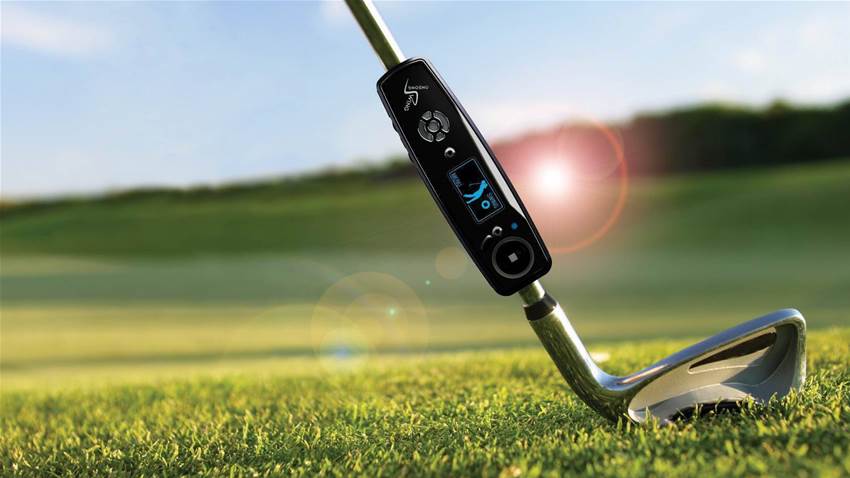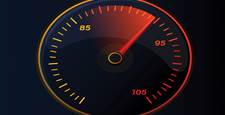When I first got the OnsongSwing in my hands I was struck by how light it was considering its detailed swing measuring capabilities.
Once attached to the club however, the OnsongSwing made a slightly noticeable difference to the swing weight, which could potentially help improve speed when the unit is taken off.
The first couple of swings with the ‘SwingSound’ turned up indicated that, like I have been told numerous times, I have a tendency to steer the club past impact rather than keeping the acceleration up. Instantly proving both the OnsongSwing’s accuracy and worth to players with certain swing faults.
HOW IT PERFORMED: The idea of a small, portable unit capable of measuring clubhead speed and acceleration makes perfect sense to me. And as anticipated I found the ability to see the speed of my eight most recent swings with each club type extremely interesting.
But it was the Onsong’s graphs and SwingSound that proved to be its most appealing and useful features.
The unit produces a graph of the golf swing’s acceleration from just before the back foot in the down swing to the follow through, displaying the interruption of impact. Every golfer has heard that they should “swing through the ball and hold their finish”, and once you have hit a few balls with the OnsongSwing you will understand just what is meant by this advice.
As I began hitting balls with the unit it showed I was accelerating the club into impact and achieving the club head speeds I would expect with each club but that I was losing a large amount of speed after impact. Having known this was a problem in my golf swing, particularly under pressure, I used the SwingSound to attempt to help better maintain acceleration over a few practice sessions.
The sound is emitted by the OnsongSwing when a player exceeds their chosen speed threshold. Working out your optimal threshold is a bit of a trial and error process, but once you have found it the sound works to ingrain the exact feeling the OnsongSwing is designed for.
When successfully executed, the sound will start near the back foot before impact and continue well into the follow through. Once I started to achieve the sound consistently in this way the graphs improved. So did my ball flight, which went slightly higher and my start line, even on slight mis-hits, was straighter.
During my testing I also lowered the speed threshold to very low and made some of the classic poor swing moves every golfer is familiar with, and this is where the performance of the SwingSound truly stood out.
A casting move at the top of the backswing caused the OnsongSwing to emit its beeping far earlier than the instructions suggest. Making it a terrific training device for players trying to eliminate such a move from their swing. The real time audio providing unbiased, instant feedback. The same was true for instant feedback on a quick takeaway.
The low threshold settings can also be used for chipping to encourage an accelerating move that helps ensure good contact and increased spin around the greens. With the beep occurring during the through swing it is highly unlikely you will stub the leading edge into the ground and hit fat chips and pitches.
Beyond the swing improvement benefits, the OnsongSwing is a great piece of technology for the inquisitive golfer. Hitting a variety of shots and looking at the graphs will help further your understanding of just what happens at impact. A heavy strike for example, displays a graph that plummets at the moment of the strike and beyond. And when compared against your best swings, which can be saved to the unit for each club type, it is easy to understand the distance affect such a mis-hit can have.
In terms of usability, the buttons, navigation and ability to customise the settings is all very user friendly. However, the small screen might be hard for some to read, but is necessary to keep the size of the unit down and have the ability to provide instant feedback right on the shaft of the club.
Although the SwingSound was the stand out feature for me, the lack of an FM receiver that allows the use of headphones with the unit, meant I was trying to find a quiet corner of the range to avoid distracting other golfers with it turned up to loud when making full swings.
When one or two others did set up next to me, however, the beep as I swung and my instant peering at the screen did result in some interested enquiries as to just what I was up to.
Overall I found the OnsongSwing to be a very useful tool for analysing a variety of different aspects of the game.
From a better player standpoint the swing speed measurements and ability to work with instant audio and visual feedback is great, while for ‘over-the-top’ swingers and those who use their speed too early the sound at the top of the backswing or start of the takeaway will instantly identify their common swing fault before they have even seen the ball take flight.
FACTS AND FIGURES
LEFT HANDED: The OnsongSwing can be easily changed to left handed in the settings, which even flips the screen to make it easier to read.
ONSONG INNOVATION SAYS: “The OnsongSwing is a micro-processor controlled device that accurately measures clubhead speed. The device attaches to the shaft adjacent to the hosel and monitors swing speed 1,000 times per second.
“When you swing the club the device records maximum swing speed and more importantly, draws a graph of club head speed during your swing. Being so close to the action end of the club, your OnsongSwing provides a unique insight into what is happening as the club head strikes its target.
“Using the graphs as a guide for your practice sessions, you can strengthen the dynamics of your golf swing, improve consistency and maximise club head acceleration through the ball.
“Like the miraculous Ch’i in martial arts, an accelerating club head delivers maximum power.”
For more information and to purchase your OnsongSwing visit www.onsongswing.com
Cost: $247.50.
Tested by: Jimmy Emanuel, Golf Australia Writer (GA Handicap 9.4)
Related Articles
.jpg&h=172&w=306&c=1&s=1)
Tested: Titleist T-Series irons

2025 Christmas Gift Guide













